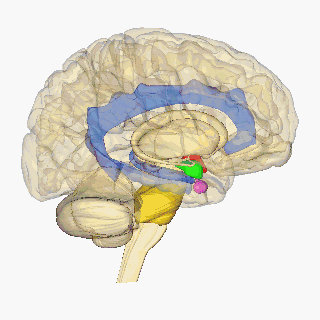
The relationship between biology and sexual orientation is a subject of on-going research. While scientists do not know the exact cause of sexual orientation, they theorize that it is caused by a complex interplay of genetic, hormonal, and environmental influences. However, evidence is weak for hypotheses that the post-natal social environment impacts sexual orientation, especially for males.
Hypersexuality is a term used for a presumed mental disorder which causes unwanted or excessive sexual arousal, causing people to engage in or think about sexual activity to a point of distress or impairment. It is controversial whether it should be included as a clinical diagnosis used by mental healthcare professionals. Nymphomania and satyriasis were terms previously used for the condition in women and men, respectively.
Pornography addiction is the scientifically controversial application of an addiction model to the use of pornography. Pornography may be part of compulsive sexual behavior with negative consequences to one's physical, mental, social, or financial well-being. While the World Health Organization's ICD-11 (2022) has recognized compulsive sexual behaviour disorder (CSBD) as an "impulsive control disorder", CSBD is not an addiction, and the American Psychiatric Association's DSM-5 (2013) and the DSM-5-TR (2022) do not classify compulsive pornography consumption as a mental disorder or a behavioral addiction.

Physical attractiveness is the degree to which a person's physical features are considered aesthetically pleasing or beautiful. The term often implies sexual attractiveness or desirability, but can also be distinct from either. There are many factors which influence one person's attraction to another, with physical aspects being one of them. Physical attraction itself includes universal perceptions common to all human cultures such as facial symmetry, sociocultural dependent attributes and personal preferences unique to a particular individual.

Reasons for opposition to pornography include religious objections and feminist concerns, as well as alleged harmful effects, such as pornography addiction. Pornography addiction is not a condition recognized by the DSM-5, or the ICD-11. Anti-pornography movements have allied disparate social activists in opposition to pornography, from social conservatives to harm reduction advocates. The definition of "pornography" varies between countries and movements, and many make distinctions between pornography, which they oppose, and erotica, which they consider acceptable. Sometimes opposition will deem certain forms of pornography more or less harmful, while others draw no such distinctions.
According to proponents of the concept, sexual addiction, also known as sex addiction, is a state characterized by compulsive participation or engagement in sexual activity, particularly sexual intercourse, despite negative consequences. The concept is contentious; neither of the two major mainstream medical categorization systems recognise sex addiction as a real medical condition, instead categorizing such behavior under labels such as compulsive sexual behavior.

Stephen Marc Breedlove is the Barnett Rosenberg professor of Neuroscience at Michigan State University in East Lansing, Michigan. He was born and raised in the Ozarks of southwestern Missouri. After graduating from Central High School in 1972, he earned a bachelor's degree in Psychology from Yale University in 1976, and a Ph.D. in psychology from UCLA in 1982. He was a professor of psychology at the University of California, Berkeley from 1982 to 2003, moving to Michigan State in 2001. He works in the fields of Behavioral Neuroscience and Neuroendocrinology. He is a member of the Society for Neuroscience and the Society for Behavioral Neuroendocrinology, and a fellow of the Association for Psychological Science (APS) and the Biological Sciences section of the American Association for the Advancement of Science (AAAS).

Pornography has been defined as any material in varying forms, including texts, video, photos or audio that is consumed for sexual satisfaction and arousal of an individual or partnership. The effects of pornography on individuals or their intimate relationships depend on the type of pornography used and differs from person to person. The consumption of Pornographic material could have both positive and negative outcomes.

Sexual selection in humans concerns the concept of sexual selection, introduced by Charles Darwin as an element of his theory of natural selection, as it affects humans. Sexual selection is a biological way one sex chooses a mate for the best reproductive success. Most compete with others of the same sex for the best mate to contribute their genome for future generations. This has shaped human evolution for many years, but reasons why humans choose their mates are not fully understood. Sexual selection is quite different in non-human animals than humans as they feel more of the evolutionary pressures to reproduce and can easily reject a mate. The role of sexual selection in human evolution has not been firmly established although neoteny has been cited as being caused by human sexual selection. It has been suggested that sexual selection played a part in the evolution of the anatomically modern human brain, i.e. the structures responsible for social intelligence underwent positive selection as a sexual ornamentation to be used in courtship rather than for survival itself, and that it has developed in ways outlined by Ronald Fisher in the Fisherian runaway model. Fisher also stated that the development of sexual selection was "more favourable" in humans.

The relationship between the environment and sexual orientation is a subject of research. In the study of sexual orientation, some researchers distinguish environmental influences from hormonal influences, while other researchers include biological influences such as prenatal hormones as part of environmental influences.

Sexual orientation is an enduring pattern of romantic or sexual attraction to persons of the opposite sex or gender, the same sex or gender, or to both sexes or more than one gender, or none of the aforementioned at all. The ultimate causes and mechanisms of sexual orientation development in humans remain unclear and many theories are speculative and controversial. However, advances in neuroscience explain and illustrate characteristics linked to sexual orientation. Studies have explored structural neural-correlates, functional and/or cognitive relationships, and developmental theories relating to sexual orientation in humans.

Human penises vary in size on a number of measures, including length and circumference when flaccid and erect. Besides the natural variability of human penises in general, there are factors that lead to minor variations in a particular male, such as the level of arousal, time of day, ambient temperature, anxiety level, physical activity, and frequency of sexual activity. Compared to other primates, including large examples such as the gorilla, the human penis is thickest, both in absolute terms and relative to the rest of the body. Most human penis growth occurs in two stages: the first between infancy and the age of five; and then between about one year after the onset of puberty and, at the latest, approximately 17 years of age.

James M. Cantor is an American-Canadian clinical psychologist and sexologist specializing in hypersexuality and paraphilias.
Compulsive sexual behaviour disorder (CSBD), is an impulse control disorder. CSBD manifests as a pattern of behavior involving intense preoccupation with sexual fantasies and behaviours that cause significant levels of psychological distress, are inappropriately used to cope with stress, cannot be voluntarily curtailed, and risk or cause harm to oneself or others. This disorder can also cause impairment in social, occupational, personal, or other important functions.
The following outline is provided as an overview of and topical guide to human sexuality:

The neuroscience of sex differences is the study of characteristics that separate brains of different sexes. Psychological sex differences are thought by some to reflect the interaction of genes, hormones, and social learning on brain development throughout the lifespan.

Animal non-reproductive sexual behavior encompasses sexual activities that non-human animals participate in which do not lead to the reproduction of the species. Although procreation continues to be the primary explanation for sexual behavior in animals, recent observations on animal behavior have given alternative reasons for the engagement in sexual activities by animals. Animals have been observed to engage in sex for social interaction bonding, exchange for significant materials, affection, mentorship pairings, sexual enjoyment, or as demonstration of social rank. Observed non-procreative sexual activities include non-copulatory mounting, oral sex, genital stimulation, anal stimulation, interspecies mating, and acts of affection, although it is doubted that they have done this since the beginning of their existence. There have also been observations of sex with cub participants, same-sex sexual interaction, as well as sex with dead animals.
NoFap is a website and community forum that serves as a support group for those who wish to give up pornography and masturbation. Its name comes from the slang term fap, referring to male masturbation. While reasons for this abstinence vary by individual, the main motivation cited is attempting to overcome addiction to pornography, or other compulsive sexual behaviours. Other reasons for abstinence include religious and moral reasons, self-improvement, and physical beliefs that are not supported by medicine.
Neurosexism is an alleged bias in the neuroscience of sex differences towards reinforcing harmful gender stereotypes. The term was coined by feminist scholar Cordelia Fine in a 2008 article and popularised by her 2010 book Delusions of Gender. The concept is now widely used by critics of the neuroscience of sex differences in neuroscience, neuroethics and philosophy.
Ivanka Savic Berglund is a Serbian-Swedish neuroscientist, a professor of neurology and chief physician at the Karolinska Institute in Sweden, and an adjunct professor in the neurology department at the University of California, Los Angeles (UCLA). Savic is best known for her neurophysiology and neuroimaging research relating to epilepsy, sex differences, sexual orientation, gender identity, brain processing of odors and pheromones, and the effects of chronic stress on the brain. Savic is a co-founder of the Stockholm Brain Institute and the editor of several medical books.









